Analysis and Evaluation of Financial Performance (M&S Plc)
VerifiedAdded on 2020/04/21
|41
|8447
|87
Report
AI Summary
This report provides a comprehensive analysis and evaluation of Marks and Spencer Plc's financial performance over a ten-year period. The study employs a quantitative research strategy, utilizing secondary data extracted from the company's financial statements. The core of the analysis revolves around the application of ratio analysis to assess key financial aspects, including profitability, liquidity, and business efficiency. The report begins with an introduction that provides the background of the company and sets the research aims and objectives. A literature review explores relevant concepts like working capital management and its impact on firm performance, along with an overview of Marks and Spencer. The methodology section details the research philosophy, variable definitions, data collection methods, and analytical procedures. The findings are presented with the help of graphs and charts. The report aims to identify financial strengths and weaknesses, and it concludes with a summary of the findings and implications for Marks and Spencer's financial strategies, especially in the context of recent financial downturns. The analysis also considers the impact of working capital management on the company's performance.
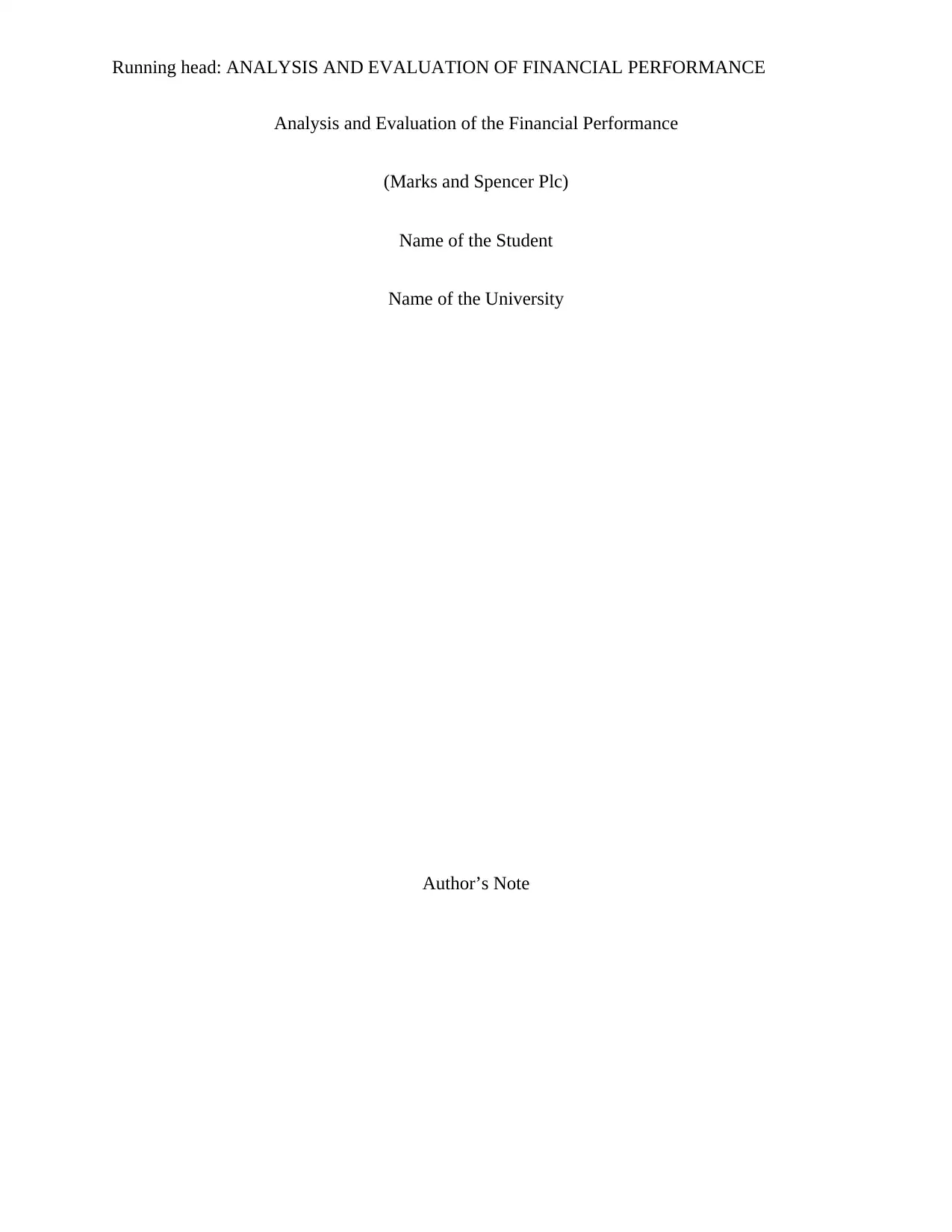
Running head: ANALYSIS AND EVALUATION OF FINANCIAL PERFORMANCE
Analysis and Evaluation of the Financial Performance
(Marks and Spencer Plc)
Name of the Student
Name of the University
Author’s Note
Analysis and Evaluation of the Financial Performance
(Marks and Spencer Plc)
Name of the Student
Name of the University
Author’s Note
Paraphrase This Document
Need a fresh take? Get an instant paraphrase of this document with our AI Paraphraser
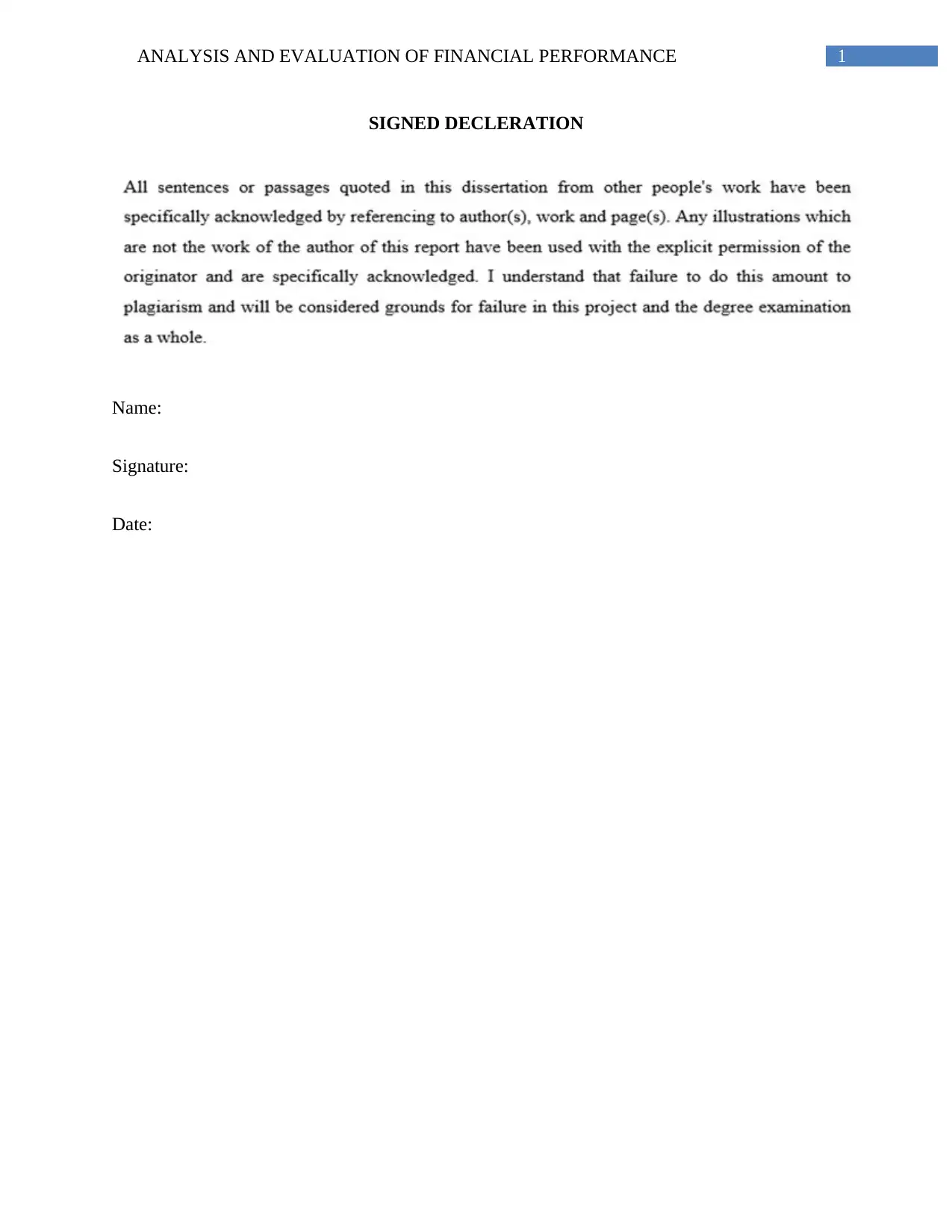
1ANALYSIS AND EVALUATION OF FINANCIAL PERFORMANCE
SIGNED DECLERATION
Name:
Signature:
Date:
SIGNED DECLERATION
Name:
Signature:
Date:
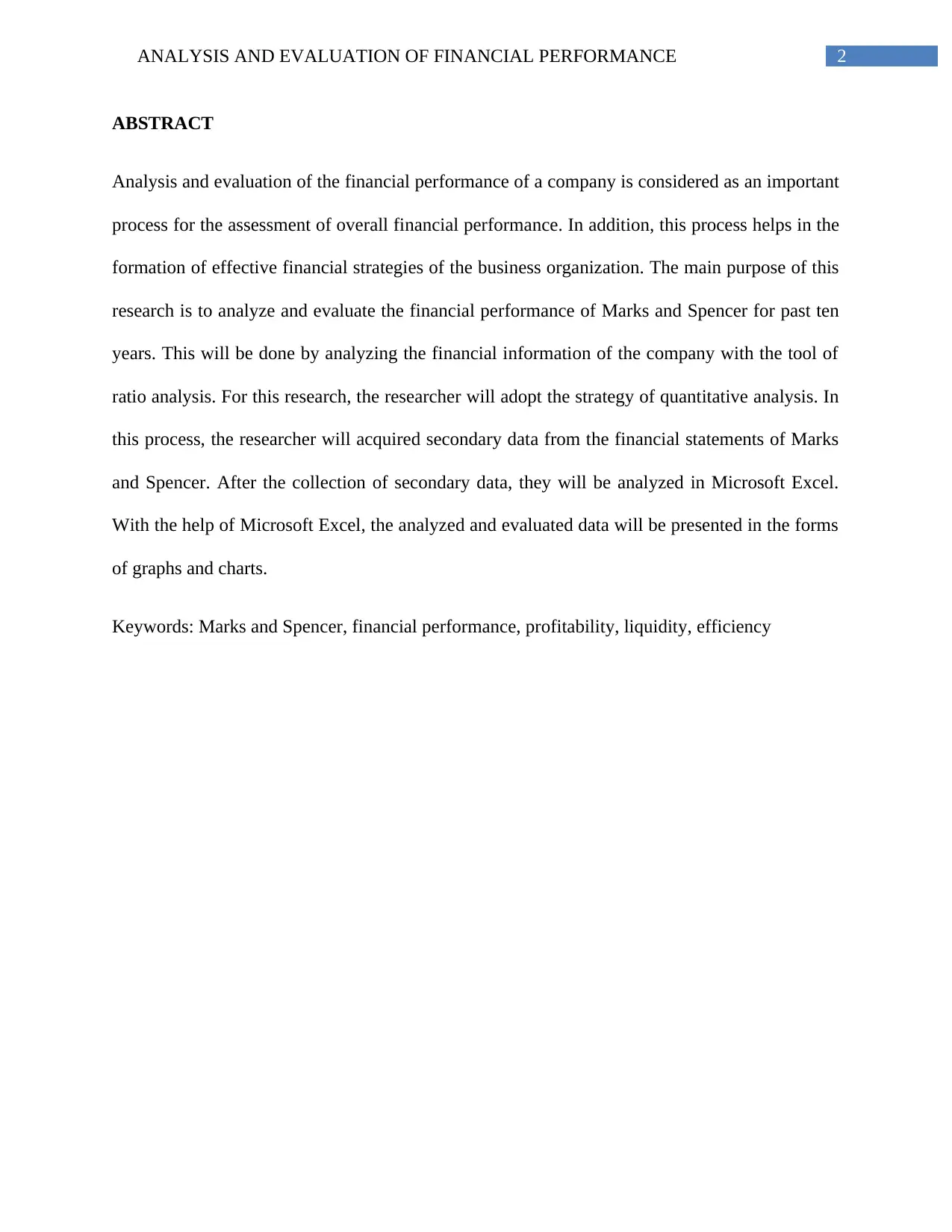
2ANALYSIS AND EVALUATION OF FINANCIAL PERFORMANCE
ABSTRACT
Analysis and evaluation of the financial performance of a company is considered as an important
process for the assessment of overall financial performance. In addition, this process helps in the
formation of effective financial strategies of the business organization. The main purpose of this
research is to analyze and evaluate the financial performance of Marks and Spencer for past ten
years. This will be done by analyzing the financial information of the company with the tool of
ratio analysis. For this research, the researcher will adopt the strategy of quantitative analysis. In
this process, the researcher will acquired secondary data from the financial statements of Marks
and Spencer. After the collection of secondary data, they will be analyzed in Microsoft Excel.
With the help of Microsoft Excel, the analyzed and evaluated data will be presented in the forms
of graphs and charts.
Keywords: Marks and Spencer, financial performance, profitability, liquidity, efficiency
ABSTRACT
Analysis and evaluation of the financial performance of a company is considered as an important
process for the assessment of overall financial performance. In addition, this process helps in the
formation of effective financial strategies of the business organization. The main purpose of this
research is to analyze and evaluate the financial performance of Marks and Spencer for past ten
years. This will be done by analyzing the financial information of the company with the tool of
ratio analysis. For this research, the researcher will adopt the strategy of quantitative analysis. In
this process, the researcher will acquired secondary data from the financial statements of Marks
and Spencer. After the collection of secondary data, they will be analyzed in Microsoft Excel.
With the help of Microsoft Excel, the analyzed and evaluated data will be presented in the forms
of graphs and charts.
Keywords: Marks and Spencer, financial performance, profitability, liquidity, efficiency
⊘ This is a preview!⊘
Do you want full access?
Subscribe today to unlock all pages.

Trusted by 1+ million students worldwide
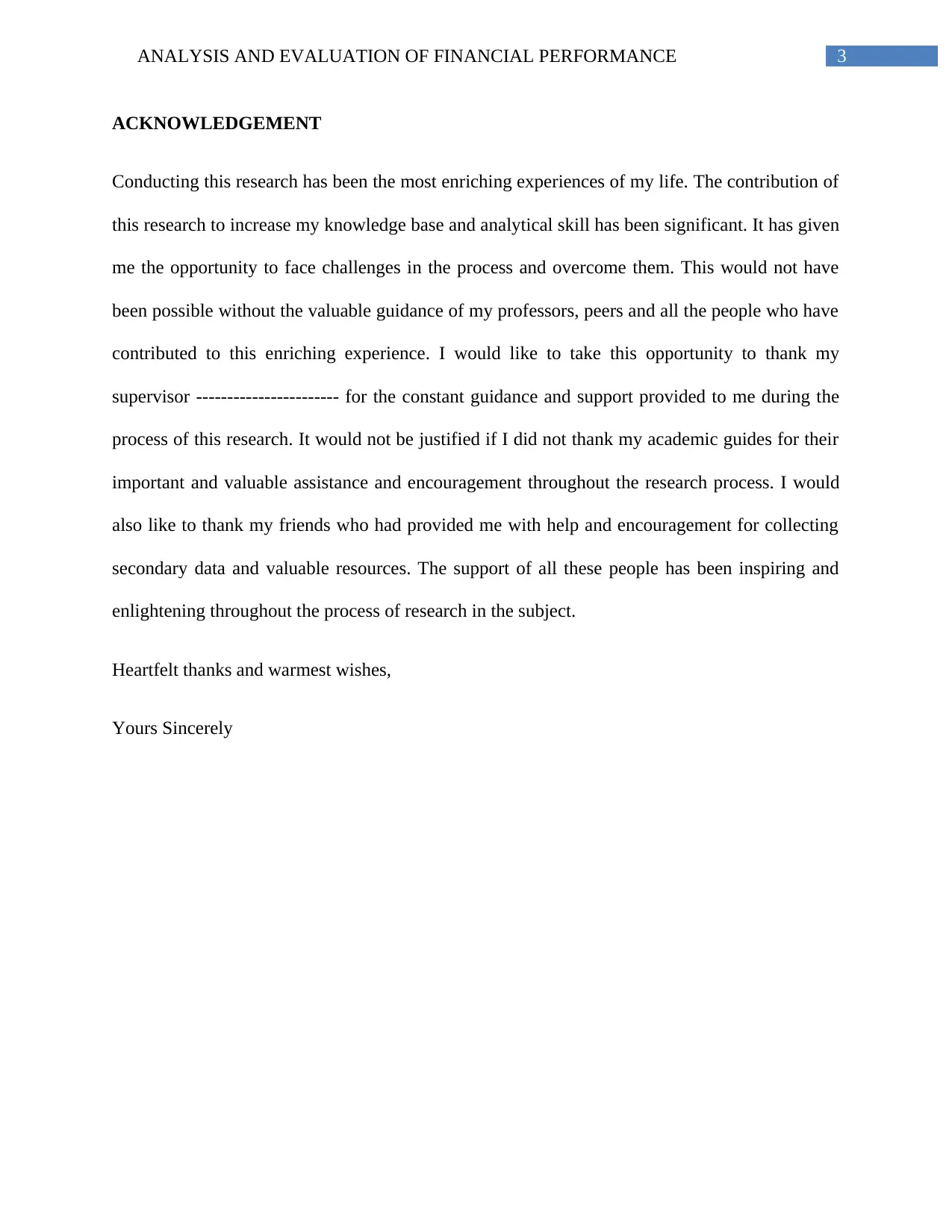
3ANALYSIS AND EVALUATION OF FINANCIAL PERFORMANCE
ACKNOWLEDGEMENT
Conducting this research has been the most enriching experiences of my life. The contribution of
this research to increase my knowledge base and analytical skill has been significant. It has given
me the opportunity to face challenges in the process and overcome them. This would not have
been possible without the valuable guidance of my professors, peers and all the people who have
contributed to this enriching experience. I would like to take this opportunity to thank my
supervisor ----------------------- for the constant guidance and support provided to me during the
process of this research. It would not be justified if I did not thank my academic guides for their
important and valuable assistance and encouragement throughout the research process. I would
also like to thank my friends who had provided me with help and encouragement for collecting
secondary data and valuable resources. The support of all these people has been inspiring and
enlightening throughout the process of research in the subject.
Heartfelt thanks and warmest wishes,
Yours Sincerely
ACKNOWLEDGEMENT
Conducting this research has been the most enriching experiences of my life. The contribution of
this research to increase my knowledge base and analytical skill has been significant. It has given
me the opportunity to face challenges in the process and overcome them. This would not have
been possible without the valuable guidance of my professors, peers and all the people who have
contributed to this enriching experience. I would like to take this opportunity to thank my
supervisor ----------------------- for the constant guidance and support provided to me during the
process of this research. It would not be justified if I did not thank my academic guides for their
important and valuable assistance and encouragement throughout the research process. I would
also like to thank my friends who had provided me with help and encouragement for collecting
secondary data and valuable resources. The support of all these people has been inspiring and
enlightening throughout the process of research in the subject.
Heartfelt thanks and warmest wishes,
Yours Sincerely
Paraphrase This Document
Need a fresh take? Get an instant paraphrase of this document with our AI Paraphraser

4ANALYSIS AND EVALUATION OF FINANCIAL PERFORMANCE
Table of Contents
1.0 INTRODUCTION.....................................................................................................................6
1.1 Background............................................................................................................................6
1.2 Research Aim and Objectives................................................................................................8
1.3 Rationale................................................................................................................................8
1.4 Scope and Limitations...........................................................................................................9
1.5 Project Outline.......................................................................................................................9
2.0 LITERATURE REVIEW........................................................................................................10
2.1 Introduction..........................................................................................................................10
2.2 Impact of Working Capital Management on the Performance of Firms.............................10
2.3 Overview of the Company...................................................................................................12
2.4 Importance of Performance Measurement...........................................................................13
2.4.1 Non-Financial Performance..........................................................................................14
2.4.2 Financial Performance..................................................................................................15
2.5 Ratio Analysis......................................................................................................................15
2.6 Summary..............................................................................................................................17
3. METHODOLOGY....................................................................................................................18
3.1 Introduction..........................................................................................................................18
3.2 Research Philosophy............................................................................................................18
Table of Contents
1.0 INTRODUCTION.....................................................................................................................6
1.1 Background............................................................................................................................6
1.2 Research Aim and Objectives................................................................................................8
1.3 Rationale................................................................................................................................8
1.4 Scope and Limitations...........................................................................................................9
1.5 Project Outline.......................................................................................................................9
2.0 LITERATURE REVIEW........................................................................................................10
2.1 Introduction..........................................................................................................................10
2.2 Impact of Working Capital Management on the Performance of Firms.............................10
2.3 Overview of the Company...................................................................................................12
2.4 Importance of Performance Measurement...........................................................................13
2.4.1 Non-Financial Performance..........................................................................................14
2.4.2 Financial Performance..................................................................................................15
2.5 Ratio Analysis......................................................................................................................15
2.6 Summary..............................................................................................................................17
3. METHODOLOGY....................................................................................................................18
3.1 Introduction..........................................................................................................................18
3.2 Research Philosophy............................................................................................................18
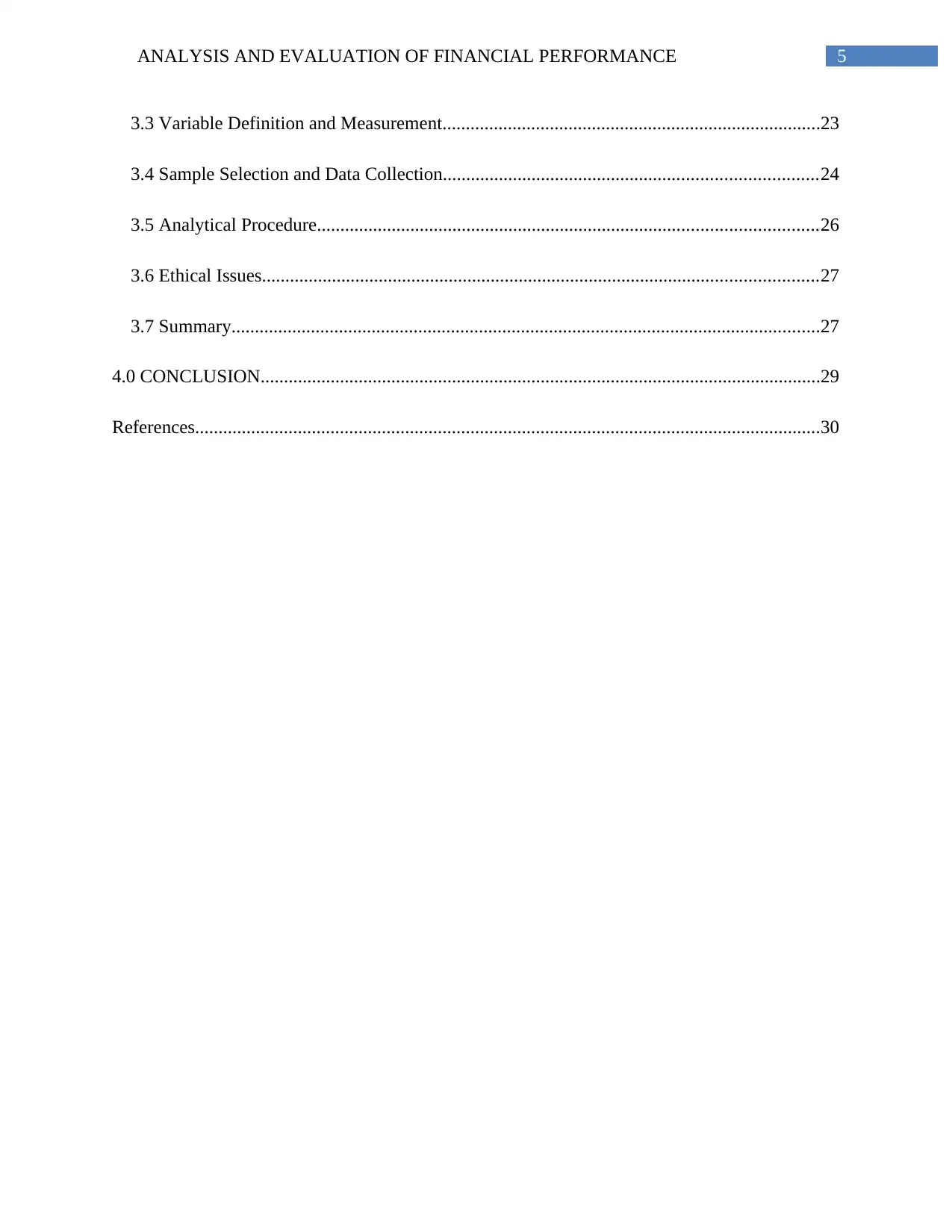
5ANALYSIS AND EVALUATION OF FINANCIAL PERFORMANCE
3.3 Variable Definition and Measurement.................................................................................23
3.4 Sample Selection and Data Collection................................................................................24
3.5 Analytical Procedure...........................................................................................................26
3.6 Ethical Issues.......................................................................................................................27
3.7 Summary..............................................................................................................................27
4.0 CONCLUSION........................................................................................................................29
References......................................................................................................................................30
3.3 Variable Definition and Measurement.................................................................................23
3.4 Sample Selection and Data Collection................................................................................24
3.5 Analytical Procedure...........................................................................................................26
3.6 Ethical Issues.......................................................................................................................27
3.7 Summary..............................................................................................................................27
4.0 CONCLUSION........................................................................................................................29
References......................................................................................................................................30
⊘ This is a preview!⊘
Do you want full access?
Subscribe today to unlock all pages.

Trusted by 1+ million students worldwide
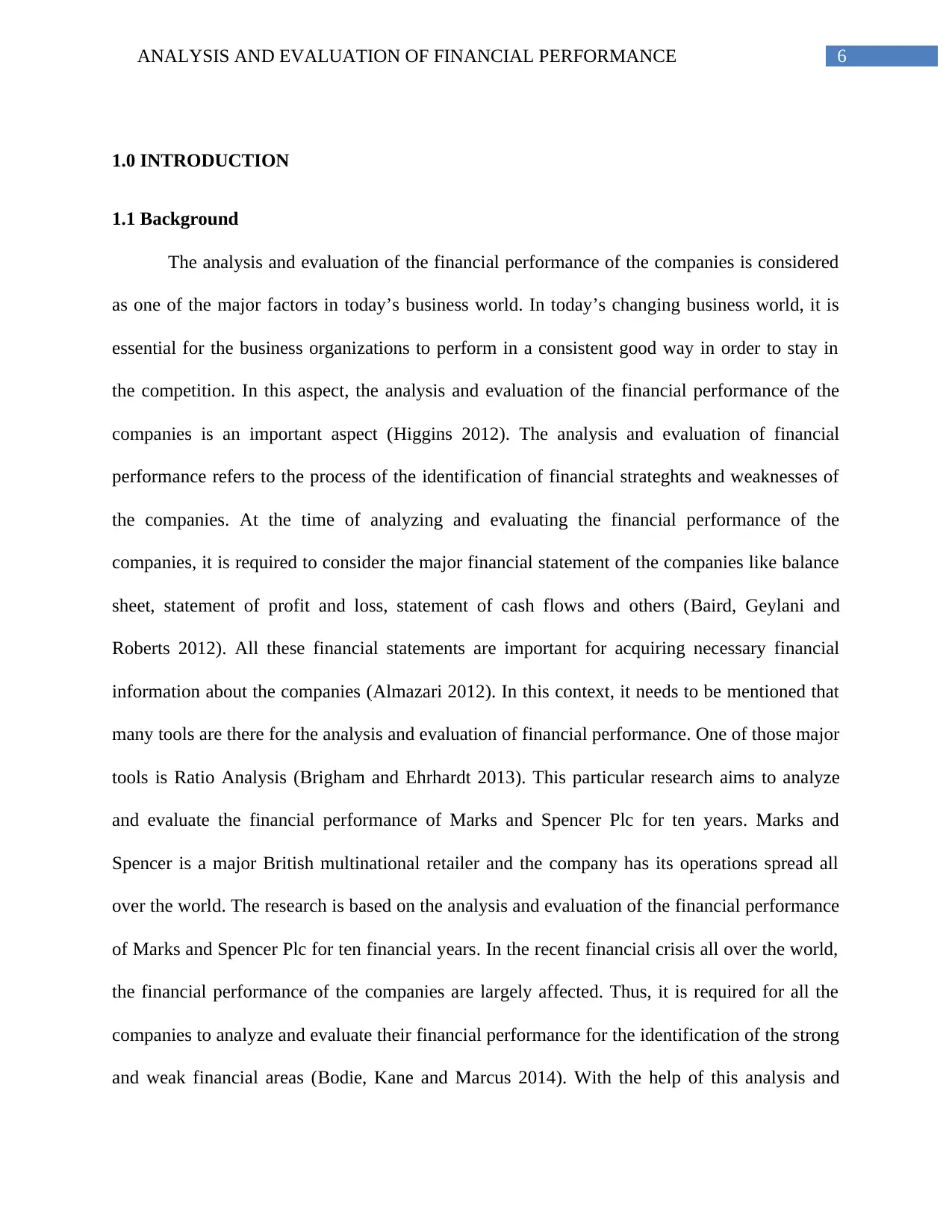
6ANALYSIS AND EVALUATION OF FINANCIAL PERFORMANCE
1.0 INTRODUCTION
1.1 Background
The analysis and evaluation of the financial performance of the companies is considered
as one of the major factors in today’s business world. In today’s changing business world, it is
essential for the business organizations to perform in a consistent good way in order to stay in
the competition. In this aspect, the analysis and evaluation of the financial performance of the
companies is an important aspect (Higgins 2012). The analysis and evaluation of financial
performance refers to the process of the identification of financial strateghts and weaknesses of
the companies. At the time of analyzing and evaluating the financial performance of the
companies, it is required to consider the major financial statement of the companies like balance
sheet, statement of profit and loss, statement of cash flows and others (Baird, Geylani and
Roberts 2012). All these financial statements are important for acquiring necessary financial
information about the companies (Almazari 2012). In this context, it needs to be mentioned that
many tools are there for the analysis and evaluation of financial performance. One of those major
tools is Ratio Analysis (Brigham and Ehrhardt 2013). This particular research aims to analyze
and evaluate the financial performance of Marks and Spencer Plc for ten years. Marks and
Spencer is a major British multinational retailer and the company has its operations spread all
over the world. The research is based on the analysis and evaluation of the financial performance
of Marks and Spencer Plc for ten financial years. In the recent financial crisis all over the world,
the financial performance of the companies are largely affected. Thus, it is required for all the
companies to analyze and evaluate their financial performance for the identification of the strong
and weak financial areas (Bodie, Kane and Marcus 2014). With the help of this analysis and
1.0 INTRODUCTION
1.1 Background
The analysis and evaluation of the financial performance of the companies is considered
as one of the major factors in today’s business world. In today’s changing business world, it is
essential for the business organizations to perform in a consistent good way in order to stay in
the competition. In this aspect, the analysis and evaluation of the financial performance of the
companies is an important aspect (Higgins 2012). The analysis and evaluation of financial
performance refers to the process of the identification of financial strateghts and weaknesses of
the companies. At the time of analyzing and evaluating the financial performance of the
companies, it is required to consider the major financial statement of the companies like balance
sheet, statement of profit and loss, statement of cash flows and others (Baird, Geylani and
Roberts 2012). All these financial statements are important for acquiring necessary financial
information about the companies (Almazari 2012). In this context, it needs to be mentioned that
many tools are there for the analysis and evaluation of financial performance. One of those major
tools is Ratio Analysis (Brigham and Ehrhardt 2013). This particular research aims to analyze
and evaluate the financial performance of Marks and Spencer Plc for ten years. Marks and
Spencer is a major British multinational retailer and the company has its operations spread all
over the world. The research is based on the analysis and evaluation of the financial performance
of Marks and Spencer Plc for ten financial years. In the recent financial crisis all over the world,
the financial performance of the companies are largely affected. Thus, it is required for all the
companies to analyze and evaluate their financial performance for the identification of the strong
and weak financial areas (Bodie, Kane and Marcus 2014). With the help of this analysis and
Paraphrase This Document
Need a fresh take? Get an instant paraphrase of this document with our AI Paraphraser
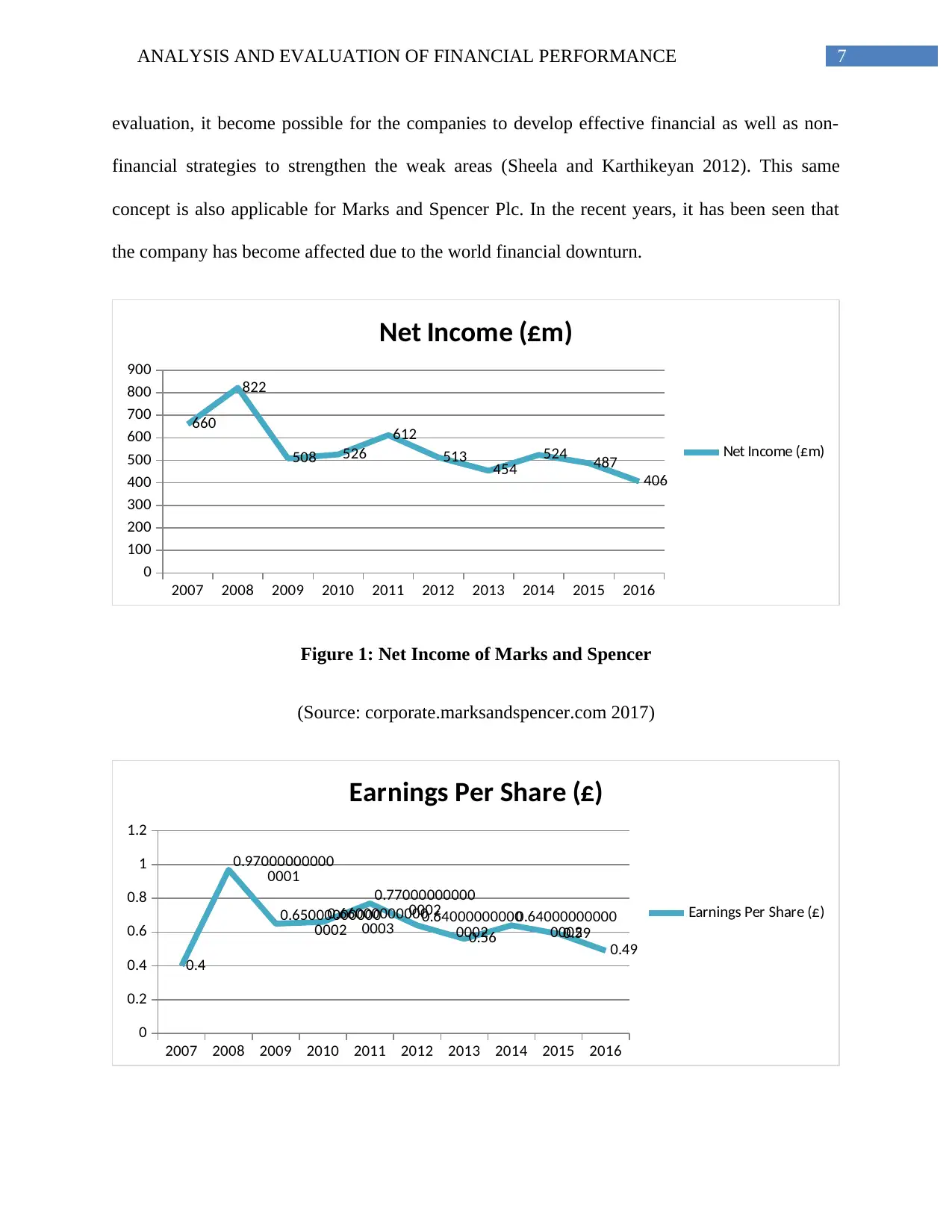
7ANALYSIS AND EVALUATION OF FINANCIAL PERFORMANCE
evaluation, it become possible for the companies to develop effective financial as well as non-
financial strategies to strengthen the weak areas (Sheela and Karthikeyan 2012). This same
concept is also applicable for Marks and Spencer Plc. In the recent years, it has been seen that
the company has become affected due to the world financial downturn.
2007 2008 2009 2010 2011 2012 2013 2014 2015 2016
0
100
200
300
400
500
600
700
800
900
660
822
508 526
612
513 454
524 487
406
Net Income (£m)
Net Income (£m)
Figure 1: Net Income of Marks and Spencer
(Source: corporate.marksandspencer.com 2017)
2007 2008 2009 2010 2011 2012 2013 2014 2015 2016
0
0.2
0.4
0.6
0.8
1
1.2
0.4
0.97000000000
0001
0.65000000000
0002
0.66000000000
0003
0.77000000000
00020.64000000000
00020.56
0.64000000000
00020.59
0.49
Earnings Per Share (£)
Earnings Per Share (£)
evaluation, it become possible for the companies to develop effective financial as well as non-
financial strategies to strengthen the weak areas (Sheela and Karthikeyan 2012). This same
concept is also applicable for Marks and Spencer Plc. In the recent years, it has been seen that
the company has become affected due to the world financial downturn.
2007 2008 2009 2010 2011 2012 2013 2014 2015 2016
0
100
200
300
400
500
600
700
800
900
660
822
508 526
612
513 454
524 487
406
Net Income (£m)
Net Income (£m)
Figure 1: Net Income of Marks and Spencer
(Source: corporate.marksandspencer.com 2017)
2007 2008 2009 2010 2011 2012 2013 2014 2015 2016
0
0.2
0.4
0.6
0.8
1
1.2
0.4
0.97000000000
0001
0.65000000000
0002
0.66000000000
0003
0.77000000000
00020.64000000000
00020.56
0.64000000000
00020.59
0.49
Earnings Per Share (£)
Earnings Per Share (£)
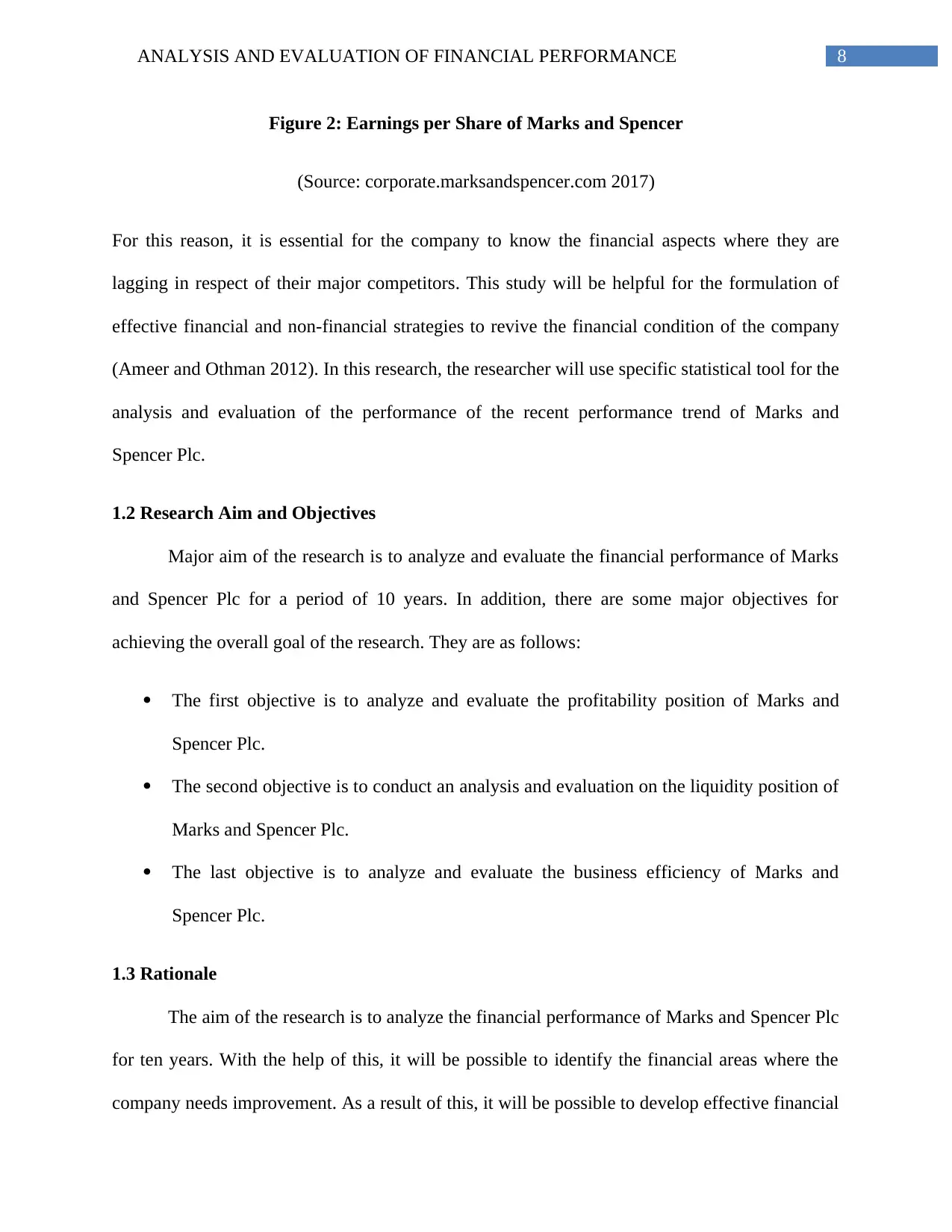
8ANALYSIS AND EVALUATION OF FINANCIAL PERFORMANCE
Figure 2: Earnings per Share of Marks and Spencer
(Source: corporate.marksandspencer.com 2017)
For this reason, it is essential for the company to know the financial aspects where they are
lagging in respect of their major competitors. This study will be helpful for the formulation of
effective financial and non-financial strategies to revive the financial condition of the company
(Ameer and Othman 2012). In this research, the researcher will use specific statistical tool for the
analysis and evaluation of the performance of the recent performance trend of Marks and
Spencer Plc.
1.2 Research Aim and Objectives
Major aim of the research is to analyze and evaluate the financial performance of Marks
and Spencer Plc for a period of 10 years. In addition, there are some major objectives for
achieving the overall goal of the research. They are as follows:
The first objective is to analyze and evaluate the profitability position of Marks and
Spencer Plc.
The second objective is to conduct an analysis and evaluation on the liquidity position of
Marks and Spencer Plc.
The last objective is to analyze and evaluate the business efficiency of Marks and
Spencer Plc.
1.3 Rationale
The aim of the research is to analyze the financial performance of Marks and Spencer Plc
for ten years. With the help of this, it will be possible to identify the financial areas where the
company needs improvement. As a result of this, it will be possible to develop effective financial
Figure 2: Earnings per Share of Marks and Spencer
(Source: corporate.marksandspencer.com 2017)
For this reason, it is essential for the company to know the financial aspects where they are
lagging in respect of their major competitors. This study will be helpful for the formulation of
effective financial and non-financial strategies to revive the financial condition of the company
(Ameer and Othman 2012). In this research, the researcher will use specific statistical tool for the
analysis and evaluation of the performance of the recent performance trend of Marks and
Spencer Plc.
1.2 Research Aim and Objectives
Major aim of the research is to analyze and evaluate the financial performance of Marks
and Spencer Plc for a period of 10 years. In addition, there are some major objectives for
achieving the overall goal of the research. They are as follows:
The first objective is to analyze and evaluate the profitability position of Marks and
Spencer Plc.
The second objective is to conduct an analysis and evaluation on the liquidity position of
Marks and Spencer Plc.
The last objective is to analyze and evaluate the business efficiency of Marks and
Spencer Plc.
1.3 Rationale
The aim of the research is to analyze the financial performance of Marks and Spencer Plc
for ten years. With the help of this, it will be possible to identify the financial areas where the
company needs improvement. As a result of this, it will be possible to develop effective financial
⊘ This is a preview!⊘
Do you want full access?
Subscribe today to unlock all pages.

Trusted by 1+ million students worldwide

9ANALYSIS AND EVALUATION OF FINANCIAL PERFORMANCE
strategies for the revival of the financial situation of Marks and Spencer Plc. Thus, in order to
develop effective strategies, it is required to carry on the research. In addition, this research will
be helpful for the researchers who want to work on this particular subject. This paper will work
as a guide for them.
1.4 Scope and Limitations
There are certain boundaries of this research. The above part shows that the researcher
will take the help of secondary data in order to measure the performance of Marks and Spencer.
It implies that there is not any scope of the collection of primary data for this research. There are
many instances where secondary data fail to reflect the original financial condition of the
business organizations. Thus, not collecting primary data can be considered as a limitation of this
research.
1.5 Project Outline
The research has four major areas. They are Introduction, Literature Review,
Methodology and Conclusion. The introduction part will have sections like background, aim and
objective, rationale and others. The literature review will have the discussion of major theories,
papers, litterateurs and others. The methodology part will include the description of processes for
the research. The conclusion part will have the summary of the total research paper.
strategies for the revival of the financial situation of Marks and Spencer Plc. Thus, in order to
develop effective strategies, it is required to carry on the research. In addition, this research will
be helpful for the researchers who want to work on this particular subject. This paper will work
as a guide for them.
1.4 Scope and Limitations
There are certain boundaries of this research. The above part shows that the researcher
will take the help of secondary data in order to measure the performance of Marks and Spencer.
It implies that there is not any scope of the collection of primary data for this research. There are
many instances where secondary data fail to reflect the original financial condition of the
business organizations. Thus, not collecting primary data can be considered as a limitation of this
research.
1.5 Project Outline
The research has four major areas. They are Introduction, Literature Review,
Methodology and Conclusion. The introduction part will have sections like background, aim and
objective, rationale and others. The literature review will have the discussion of major theories,
papers, litterateurs and others. The methodology part will include the description of processes for
the research. The conclusion part will have the summary of the total research paper.
Paraphrase This Document
Need a fresh take? Get an instant paraphrase of this document with our AI Paraphraser
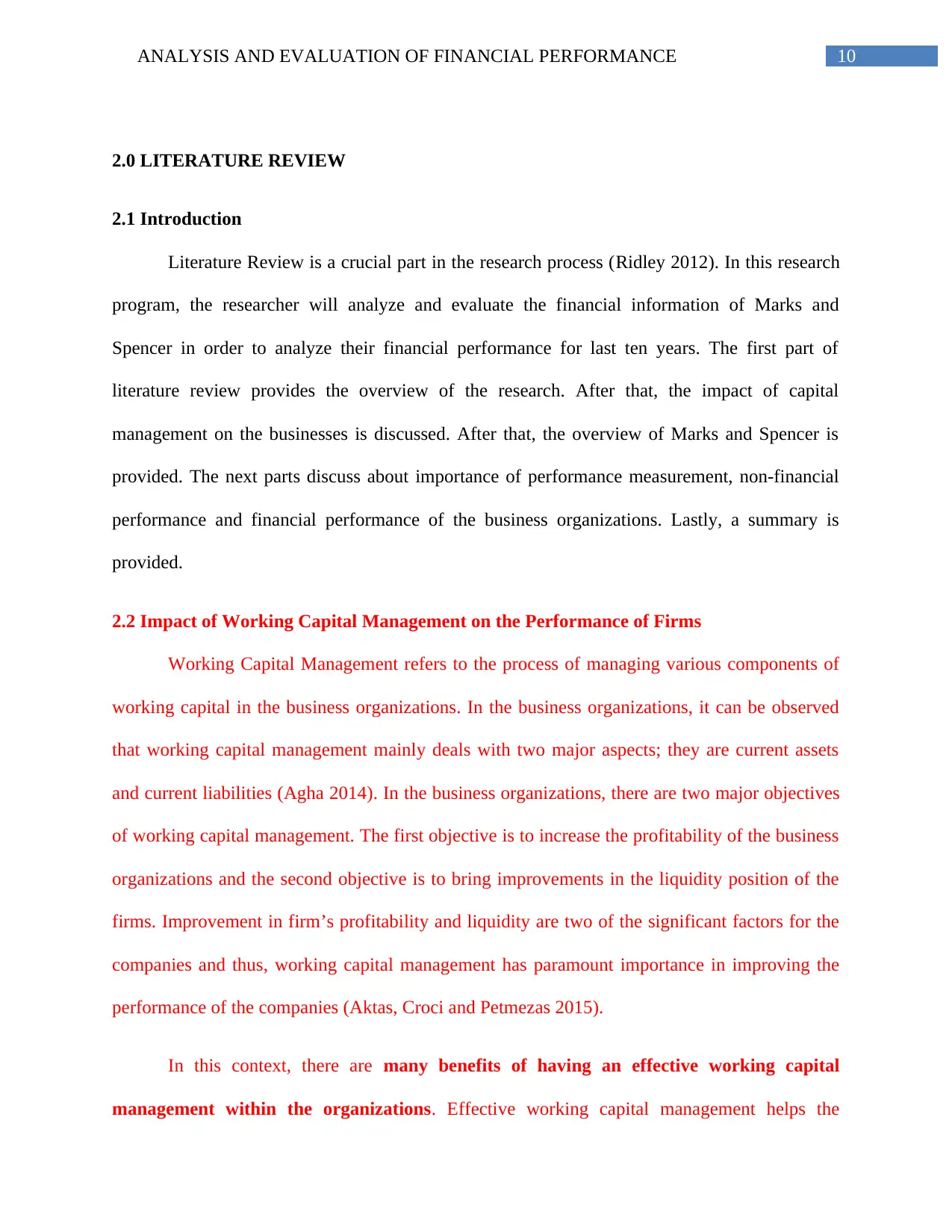
10ANALYSIS AND EVALUATION OF FINANCIAL PERFORMANCE
2.0 LITERATURE REVIEW
2.1 Introduction
Literature Review is a crucial part in the research process (Ridley 2012). In this research
program, the researcher will analyze and evaluate the financial information of Marks and
Spencer in order to analyze their financial performance for last ten years. The first part of
literature review provides the overview of the research. After that, the impact of capital
management on the businesses is discussed. After that, the overview of Marks and Spencer is
provided. The next parts discuss about importance of performance measurement, non-financial
performance and financial performance of the business organizations. Lastly, a summary is
provided.
2.2 Impact of Working Capital Management on the Performance of Firms
Working Capital Management refers to the process of managing various components of
working capital in the business organizations. In the business organizations, it can be observed
that working capital management mainly deals with two major aspects; they are current assets
and current liabilities (Agha 2014). In the business organizations, there are two major objectives
of working capital management. The first objective is to increase the profitability of the business
organizations and the second objective is to bring improvements in the liquidity position of the
firms. Improvement in firm’s profitability and liquidity are two of the significant factors for the
companies and thus, working capital management has paramount importance in improving the
performance of the companies (Aktas, Croci and Petmezas 2015).
In this context, there are many benefits of having an effective working capital
management within the organizations. Effective working capital management helps the
2.0 LITERATURE REVIEW
2.1 Introduction
Literature Review is a crucial part in the research process (Ridley 2012). In this research
program, the researcher will analyze and evaluate the financial information of Marks and
Spencer in order to analyze their financial performance for last ten years. The first part of
literature review provides the overview of the research. After that, the impact of capital
management on the businesses is discussed. After that, the overview of Marks and Spencer is
provided. The next parts discuss about importance of performance measurement, non-financial
performance and financial performance of the business organizations. Lastly, a summary is
provided.
2.2 Impact of Working Capital Management on the Performance of Firms
Working Capital Management refers to the process of managing various components of
working capital in the business organizations. In the business organizations, it can be observed
that working capital management mainly deals with two major aspects; they are current assets
and current liabilities (Agha 2014). In the business organizations, there are two major objectives
of working capital management. The first objective is to increase the profitability of the business
organizations and the second objective is to bring improvements in the liquidity position of the
firms. Improvement in firm’s profitability and liquidity are two of the significant factors for the
companies and thus, working capital management has paramount importance in improving the
performance of the companies (Aktas, Croci and Petmezas 2015).
In this context, there are many benefits of having an effective working capital
management within the organizations. Effective working capital management helps the
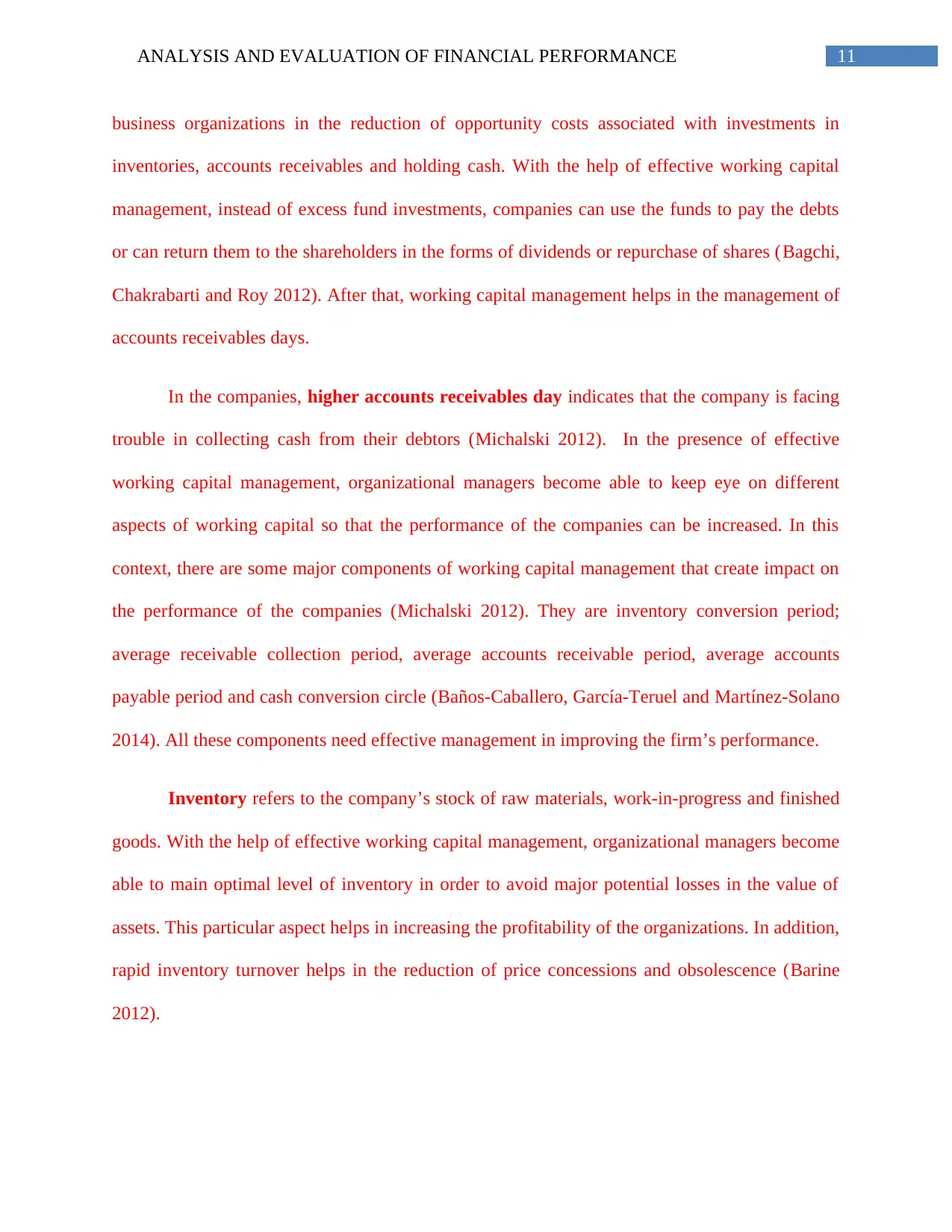
11ANALYSIS AND EVALUATION OF FINANCIAL PERFORMANCE
business organizations in the reduction of opportunity costs associated with investments in
inventories, accounts receivables and holding cash. With the help of effective working capital
management, instead of excess fund investments, companies can use the funds to pay the debts
or can return them to the shareholders in the forms of dividends or repurchase of shares (Bagchi,
Chakrabarti and Roy 2012). After that, working capital management helps in the management of
accounts receivables days.
In the companies, higher accounts receivables day indicates that the company is facing
trouble in collecting cash from their debtors (Michalski 2012). In the presence of effective
working capital management, organizational managers become able to keep eye on different
aspects of working capital so that the performance of the companies can be increased. In this
context, there are some major components of working capital management that create impact on
the performance of the companies (Michalski 2012). They are inventory conversion period;
average receivable collection period, average accounts receivable period, average accounts
payable period and cash conversion circle (Baños-Caballero, García-Teruel and Martínez-Solano
2014). All these components need effective management in improving the firm’s performance.
Inventory refers to the company’s stock of raw materials, work-in-progress and finished
goods. With the help of effective working capital management, organizational managers become
able to main optimal level of inventory in order to avoid major potential losses in the value of
assets. This particular aspect helps in increasing the profitability of the organizations. In addition,
rapid inventory turnover helps in the reduction of price concessions and obsolescence (Barine
2012).
business organizations in the reduction of opportunity costs associated with investments in
inventories, accounts receivables and holding cash. With the help of effective working capital
management, instead of excess fund investments, companies can use the funds to pay the debts
or can return them to the shareholders in the forms of dividends or repurchase of shares (Bagchi,
Chakrabarti and Roy 2012). After that, working capital management helps in the management of
accounts receivables days.
In the companies, higher accounts receivables day indicates that the company is facing
trouble in collecting cash from their debtors (Michalski 2012). In the presence of effective
working capital management, organizational managers become able to keep eye on different
aspects of working capital so that the performance of the companies can be increased. In this
context, there are some major components of working capital management that create impact on
the performance of the companies (Michalski 2012). They are inventory conversion period;
average receivable collection period, average accounts receivable period, average accounts
payable period and cash conversion circle (Baños-Caballero, García-Teruel and Martínez-Solano
2014). All these components need effective management in improving the firm’s performance.
Inventory refers to the company’s stock of raw materials, work-in-progress and finished
goods. With the help of effective working capital management, organizational managers become
able to main optimal level of inventory in order to avoid major potential losses in the value of
assets. This particular aspect helps in increasing the profitability of the organizations. In addition,
rapid inventory turnover helps in the reduction of price concessions and obsolescence (Barine
2012).
⊘ This is a preview!⊘
Do you want full access?
Subscribe today to unlock all pages.

Trusted by 1+ million students worldwide
1 out of 41
Related Documents
Your All-in-One AI-Powered Toolkit for Academic Success.
+13062052269
info@desklib.com
Available 24*7 on WhatsApp / Email
![[object Object]](/_next/static/media/star-bottom.7253800d.svg)
Unlock your academic potential
Copyright © 2020–2025 A2Z Services. All Rights Reserved. Developed and managed by ZUCOL.





